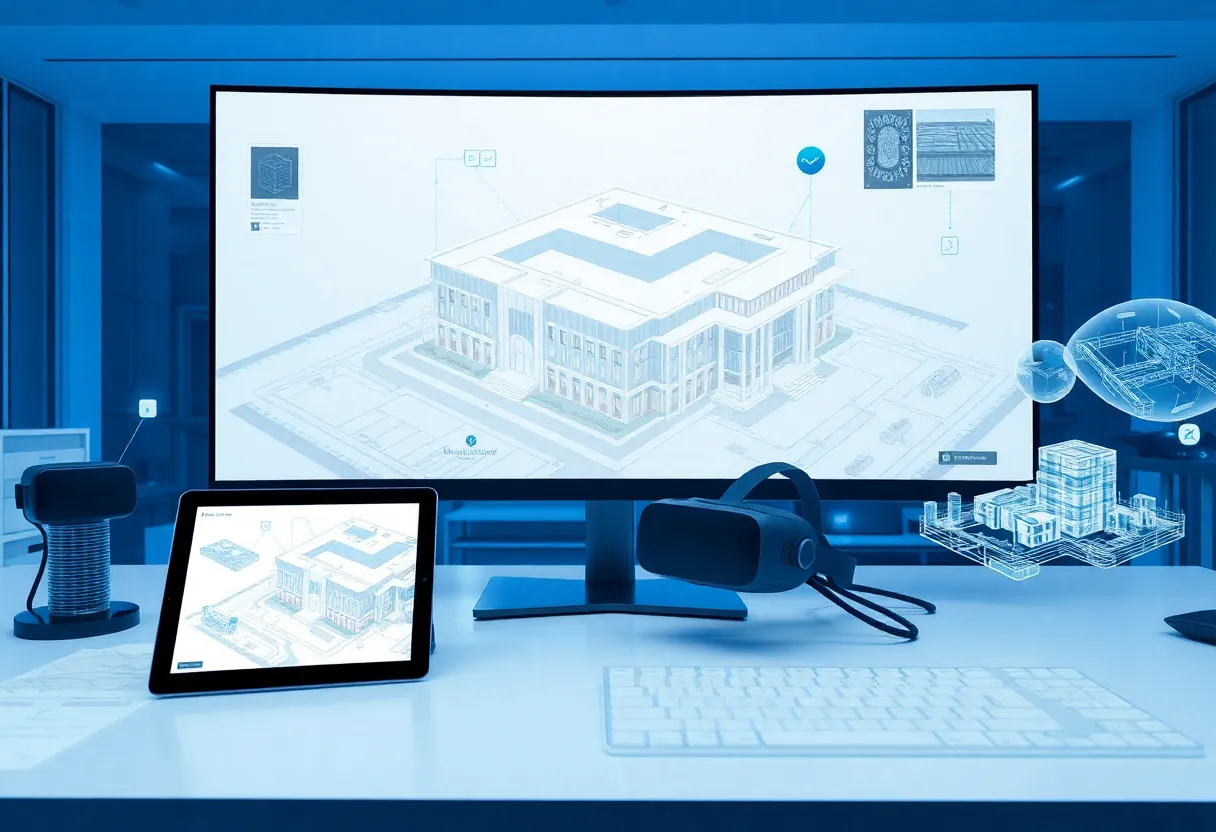Global, August 13, 2025
News Summary
Revizto has rolled out a Unity-built, cross-platform BIM collaboration layer designed to federate very large models and centralize coordination and issue management. The cloud-enabled platform fuses 2D drawings into 3D model views so markups remain spatially linked, supports real-time clash detection and issue tracking, and handles point clouds and lightweight mesh workflows. Native desktop and mobile apps plus a web-based issue tracker enable offline and browser access. Optimization reduces polygon and texture weight to keep giga-models interactive, while plugins and imports preserve interoperability with common AEC authoring tools.
Revizto’s Unity-based, cross‑platform BIM collaboration platform moves high‑volume projects toward open, real‑time coordination
Revizto is described as a cloud‑based BIM coordination, collaboration, and issue management tool designed to unify 2D and 3D BIM intelligence across project teams. The product runs on the Unity game engine technology, enabling a seamless fusion of 2D drawings with 3D model views in a single viewer. This hybrid 2D/3D fusion experience is paired with real‑time BIM coordination, clash detection, and issue tracking, with the aim of reducing rework and speeding up decision making on complex projects that span multiple jurisdictions and disciplines.
Revizto frames itself as a cloud‑era application but emphasizes that its core functionality remains accessible through native desktop and mobile apps. A web‑based issue tracker extends access to users on Mac, Windows, or Linux via modern browsers, while the native apps run on Mac and Windows desktops as well as iOS and Android devices. The approach blends cloud‑centric workflows with offline‑friendly, device‑level experiences so field teams and office staff can collaborate without constant connectivity constraints.
Technology, scale, and data handling
The engineering team has built roughly seven million lines of code atop the Unity engine and claims to leverage only about 7% of Unity’s capabilities for Revizto’s needs. The platform positions itself as able to ingest and generate lightweight, high‑fidelity equivalents from a variety of CAD and modeling kernels, with the ability to handle very large datasets. Company statements note that Revizto can work with the world’s largest BIM and infrastructure projects, sometimes described as giga projects, and the team has reported consuming more than 280 terabytes of project data to date. Special minimization and optimization techniques, including reducing polygon counts, are part of the strategy to keep heavy, multi‑source models responsive in real time.
Interoperability and openness
A core feature is openness and platform agnosticism. Revizto maintains direct plugins and imports from a broad set of authoring tools, and it supports interoperability with Autodesk products (Revit, Navisworks, AutoCAD, Civil 3D), Trimble SketchUp, Bentley and Nemetschek tools (ArchiCAD, Vectorworks), Rhino, Tekla, and other common AEC platforms. It can ingest meshes and OBJ files as inputs and has added full point cloud integration as a recent enhancement. The system is designed to federate data from multiple sources, enabling federated BIM coordination across diverse software ecosystems while preserving a shared coordinate framework so markups and models align across tools.
The platform’s OpenBIM orientation and emphasis on being platform agnostic aim to smooth collaboration among stakeholders who use different authoring environments. Revizto has developed plugins for many tools and supports direct imports from a wide array of sources, reinforcing its stance that no single vendor can serve all needs in global AEC markets.
2D/3D viewer, markups, and reporting
Revizto provides a 2D/3D hybrid viewer where markups and stamps float in 3D space and remain bi‑directionally linked between 2D drawings and 3D models. These markups carry metadata such as issue properties, tags, and assignees, and they stay spatially positioned as users switch between views. The system supports the preparation of scheduled reports and dashboards, which can be exported to PDF and filtered across devices. The markup system is central to Revizto’s collaboration approach and is designed to be simple enough for broad adoption, including field personnel who may not be deep technical users.
In addition to core viewers, Revizto offers an issue manager described in some coverage as best‑in‑breed, with robust clash detection for modeling coordination. The aim is to centralize communication across design, review, coordination, and construction phases and to carry BIM intelligence from authoring tools into the review and field spaces. A powerful search engine underpins the reporting system, helping teams locate issues and their related data quickly.
Virtual reality, augmented reality, and device reach
The technology stack includes support for VR platforms and headsets such as HTC Vive and Oculus, enabling immersive navigation of project models and site spaces. Revizto has outlined an AR roadmap with tablets as the initial target for AR experiences, illustrating a path toward hands‑free data interaction on site. The product’s multi‑device strategy extends to a wide array of hardware: computers, tablets, and smartphones, designed to keep information accessible wherever project teams are located.
Adoption, packages, and market positioning
Revizto sells to AEC/O stakeholders through packages tailored to different user groups. General contractors and large owners can purchase a single license that unlocks unlimited users and project‑based pricing, while architects, engineers, and interior designers see model‑based pricing. The company also offers discounted pricing for architects and engineers when used by themselves, with incentives for owners or GCs to provide Revizto access for project work. The positioning emphasizes collaboration and coordination rather than authoring, MCAD tooling, or media production; the aim is to deliver a single source of truth that federates BIM data across participants and tools.
Geographic distribution and user composition have been cited as roughly 30% of users in Europe and the Middle East, 30% in APAC, and 40% in the Americas. Australia and New Zealand are noted for advanced BIM workflows and automation. About 60% of core customers are general contractors, with the remaining 40% comprising a mix of owners, engineers, architects, interior designers, facilities managers, and other specialists. The platform has seen adoption in sectors where fast iteration and field collaboration are valued, including facilities management tasks in airports that digitized operations during the COVID period.
Roadmap, ecosystem, and competitive landscape
Revizto’s roadmap includes continued AR capabilities and deeper integration with VR and immersive navigation. The company emphasizes openness and compatibility with a broad ecosystem of tools, arguing that no single vendor can fully serve the diverse global AEC market. It cites industry dynamics around open APIs and interoperability, noting recent discussions around shared open APIs among major players. In terms of competitive positioning, Revizto focuses on collaboration and coordination, not as a wholesale replacement for CDEs or authoring tools. Competitors in the broader market that offer BIM viewing and project coordination often include other large ecosystems, but Revizto emphasizes its distinct focus on cross‑tool coordination, large model support, and field‑level usability.
Conclusion: a viewer for coordinated BIM across the globe
Across its offerings, Revizto aims to unify multiple data streams, facilitate real‑time coordination, and enable stakeholders to interact with very large BIM data in an intuitive way. By combining a Unity‑driven cross‑platform delivery model with open data flows, strong 2D/3D alignment, and a field‑friendly interface, the platform seeks to reduce waste, speed up issue resolution, and improve accountability on giga projects around the world. The ongoing emphasis on openness, interoperability, and a practical approach to AR/VR suggests a continued push toward a more connected, real‑time, cross‑discipline BIM workflow.
Key features
| Feature | Description | Impact |
|---|---|---|
| 2D/3D fusion viewer | Integrated view that overlays 2D drawings with 3D BIM models | Improves spatial understanding and reduces misalignment between drawings and models |
| Real‑time coordination and clash detection | Live coordination checks during design and review | Speeds up resolution of conflicts and reduces rework |
| Issue tracking and stamping | Bi‑directional markups with metadata and assignees | Streamlines assignment, tracking, and reporting of issues |
| Cross‑platform delivery | Native desktop and mobile apps plus web access | Broader adoption across field and office teams |
| Wide interoperability | Supports Revit, Navisworks, AutoCAD, Civil 3D, SketchUp, ArchiCAD, Vectorworks, Rhino, Tekla, and more | Prevents vendor lock‑in and eases multi‑tool workflows |
| OBJ/mesh/point cloud support | Ingests multiple data formats, including point clouds | Enables large and diverse data sets to be used in coordination |
| VR/AR support | VR headsets and AR roadmap with tablets as initial target | Provides immersive review and on‑site data access |
| Reporting and dashboards | Powerful search and printable reports | Improves traceability and decision documentation |
| Open, platform‑agnostic approach | Designed to work with many authoring tools and data sources | Supports diverse project ecosystems and reduces data silos |
| Scalable to giga projects | Designed to handle very large models and datasets | Suitable for large, complex infrastructure programs |
Frequently asked questions
What is Revizto?
Revizto is a cross‑platform BIM coordination, collaboration, and issue management tool built on the Unity engine. It combines 2D and 3D BIM views, real‑time coordination, and a structured issue workflow to support design review and field collaboration.
What platforms does Revizto support?
The core functionality is available through native desktop apps for Mac and Windows, mobile apps for iOS and Android, and a web‑based issue tracker accessible from modern browsers.
How does Revizto handle large BIM models?
Revizto uses optimization techniques and ingests data from multiple CAD/modeling kernels. It is designed to manage very large federated models and has consumed hundreds of terabytes of project data to date while minimizing polygon counts to maintain performance.
Which tools and formats does Revizto interoperate with?
Revizto interoperates with Autodesk Revit, Navisworks, AutoCAD, Civil 3D, Trimble SketchUp, Bentley and Nemetschek products, Rhino, Tekla, and other common authoring platforms, and supports OBJ meshes and point clouds.
What is unique about Revizto’s 2D/3D workflow?
The platform provides bi‑directional linking between 2D drawings and 3D models, with markups that carry metadata and remain spatially positioned across views, enabling consistent cross‑tool coordination.
What is the pricing model?
Revizto offers packages tailored to roles: general contractors and large owners can purchase licenses that cover unlimited users; architects, engineers, and designers use model‑based pricing, with discounts when used alone or in coordination with owners or GCs.
Does Revizto support VR and AR?
Yes, Revizto supports VR headsets for immersive navigation and has an AR roadmap with tablets as the initial target for augmented reality experiences.
What is Revizto’s competitive stance?
The platform emphasizes collaboration, openness, and the ability to handle large, federated models, while positioning itself away from authority over authoring tools or CDEs, focusing instead on coordination and field usability.
How global is Revizto’s user base?
Geographically, users are spread across Europe, the Middle East, APAC, and the Americas, with a distribution that places roughly equal shares in Europe/Middle East and APAC, and a larger share in the Americas.
What is on Revizto’s roadmap?
Ongoing AR integration, broader VR/immersive navigation capabilities, and continued enhancements to openness and interoperability are highlighted parts of the roadmap.
Deeper Dive: News & Info About This Topic
Additional Resources
- Architosh: Inside Revizto — Global dominance with open BIM coordination
- Wikipedia: Building information modeling
- GeoWeek: Revizto — a look into the future of 2D/3D data fusion and collaboration
- Google Search: Revizto 2D 3D data fusion collaboration
- BBC News: Business coverage (related resource)
- Encyclopedia Britannica: Unity (game engine)
- BBC Somali: Aqoon-Guud (related coverage)
- Google News: Revizto
- Revizto (official site)
- Google Scholar: building information modeling clash detection





